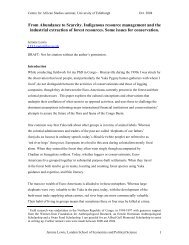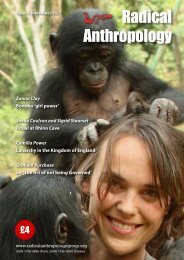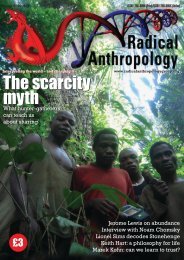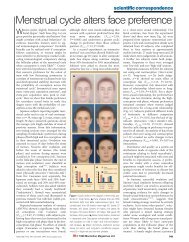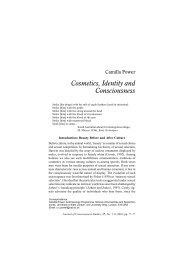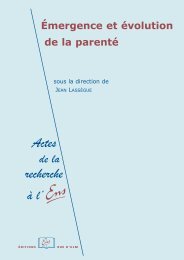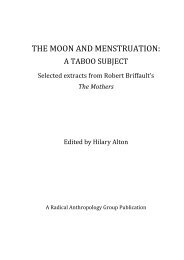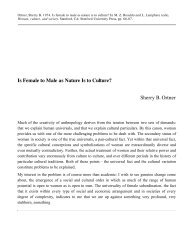Language and life history: A new perspective on the development ...
Language and life history: A new perspective on the development ...
Language and life history: A new perspective on the development ...
- No tags were found...
Create successful ePaper yourself
Turn your PDF publications into a flip-book with our unique Google optimized e-Paper software.
Commentary/Locke & Bogin: <str<strong>on</strong>g>Language</str<strong>on</strong>g> <str<strong>on</strong>g>and</str<strong>on</strong>g> <str<strong>on</strong>g>life</str<strong>on</strong>g> <str<strong>on</strong>g>history</str<strong>on</strong>g>Melody as a primordial legacy from early rootsof languageKathleen Wermke a <str<strong>on</strong>g>and</str<strong>on</strong>g> Werner Mende ba Center for Pre-Speech-Development <str<strong>on</strong>g>and</str<strong>on</strong>g> Developmental Disorders,Julius-Maximilians-University, Würzburg, Würzburg, 97070, Germany;b Berlin-Br<str<strong>on</strong>g>and</str<strong>on</strong>g>enburg Academy of Science, Berlin, 10117, Germany.wermke_k@klinik.uni-wuerzburg.de mende@bbaw.deAbstract: The stormy <strong>development</strong> of vocal producti<strong>on</strong> during <strong>the</strong> firstpostnatal weeks is generally underestimated. Our l<strong>on</strong>gitudinal studiesrevealed an amazingly fast unfolding <str<strong>on</strong>g>and</str<strong>on</strong>g> combinatorial complexificati<strong>on</strong>of pre-speech melodies. We argue that relying <strong>on</strong> “melody” couldprovide for <strong>the</strong> immature brain a kind of filter to extract <str<strong>on</strong>g>life</str<strong>on</strong>g>-relevantinformati<strong>on</strong> from <strong>the</strong> complex speech stream.Locke & Bogin (L&B) emphasize that <strong>the</strong> “<strong>development</strong> oflanguage requires <strong>the</strong> whole of modern human <strong>on</strong>togeny”(target article, Abstract) <str<strong>on</strong>g>and</str<strong>on</strong>g> point out that <strong>the</strong> human braingrows at a very fast pace during infancy. Fur<strong>the</strong>rmore, <strong>the</strong>ystress a disparity of brain growth after birth in comparis<strong>on</strong> too<strong>the</strong>r primates. We str<strong>on</strong>gly support <str<strong>on</strong>g>and</str<strong>on</strong>g> complement L&B’s<str<strong>on</strong>g>life</str<strong>on</strong>g> <str<strong>on</strong>g>history</str<strong>on</strong>g> based <str<strong>on</strong>g>perspective</str<strong>on</strong>g> <strong>on</strong> language <strong>development</strong> by <str<strong>on</strong>g>new</str<strong>on</strong>g>data from <strong>the</strong> earliest period of infancy.Our investigati<strong>on</strong>s are focused <strong>on</strong> <strong>the</strong> time functi<strong>on</strong> of <strong>the</strong> fundamentalfrequency (melody) of infants’ utterances. Melody invocal communicati<strong>on</strong> is a legacy from <strong>the</strong> early roots of orallanguage; it can be traced al<strong>on</strong>g <strong>the</strong> entire <strong>on</strong>togeny <str<strong>on</strong>g>and</str<strong>on</strong>g> it isan essential c<strong>on</strong>stituent of prosody. In <strong>on</strong>togeny, its primacy isreflected in <strong>the</strong> amazing perceptive capacities of <str<strong>on</strong>g>new</str<strong>on</strong>g>borns <str<strong>on</strong>g>and</str<strong>on</strong>g>young infants for melody recogniti<strong>on</strong> (e.g., Fernald 1989; Nazziet al. 1998; Ramus et al. 2000; Sansavini et al. 1997) <str<strong>on</strong>g>and</str<strong>on</strong>g> in <strong>the</strong>ast<strong>on</strong>ishing melody-related performances of <strong>the</strong>ir vocal producti<strong>on</strong>(Wermke 2002).L<strong>on</strong>gitudinal twin studies have revealed a unidirecti<strong>on</strong>al <strong>development</strong>from simple to complex cries during <strong>the</strong> first weeks of <str<strong>on</strong>g>life</str<strong>on</strong>g>(Wermke 2002; Wermke & Friederici 2004; Wermke et al. 1996).In a subsequent study we applied a ma<strong>the</strong>matical model in orderto quantitatively compare melody properties of different vocalizati<strong>on</strong>ssuch as soft cries, cooing, <str<strong>on</strong>g>and</str<strong>on</strong>g> babbling. A c<strong>on</strong>tinuous unfoldingof melody structures during infancy <str<strong>on</strong>g>and</str<strong>on</strong>g> a high structuralsimilarity between melodies of different pre-speech phases wasdem<strong>on</strong>strated (Wermke et al., in preparati<strong>on</strong>). Fur<strong>the</strong>rmore, aunidirecti<strong>on</strong>al decrease of melody-arc durati<strong>on</strong> <str<strong>on</strong>g>and</str<strong>on</strong>g> FM-amplitudewas observed <strong>on</strong> <strong>the</strong> <strong>development</strong>al path from early crying tospeech-like babbling. These parameters c<strong>on</strong>verge during earlyinfancy toward <strong>the</strong> range of int<strong>on</strong>ati<strong>on</strong> comp<strong>on</strong>ents in laterlanguage. Although melody is a key parameter for characterizinginfants’ utterances during <strong>the</strong> first m<strong>on</strong>ths, o<strong>the</strong>r parameters,describing <strong>the</strong> voluntary c<strong>on</strong>trol of <strong>the</strong> vocal tract, become increasinglyimportant. Beginning at about age three m<strong>on</strong>ths, an increasingarticulatory activity was identified, c<strong>on</strong>nected with couplingphenomena between melody (ph<strong>on</strong>ati<strong>on</strong>) <str<strong>on</strong>g>and</str<strong>on</strong>g> res<strong>on</strong>ance properties(articulati<strong>on</strong>; Wermke et al. 2002; Wermke et al. 2005).These processes represent amazingly systematic preparati<strong>on</strong>phases exercising <strong>the</strong> fast transiti<strong>on</strong>s of res<strong>on</strong>ance frequencies (formants)necessary for speech. The establishment of intenti<strong>on</strong>alinteracti<strong>on</strong> between melody <str<strong>on</strong>g>and</str<strong>on</strong>g> formants <str<strong>on</strong>g>and</str<strong>on</strong>g> a mastering offast formant transiti<strong>on</strong>s seem to require such a training periodbefore being available for intenti<strong>on</strong>al use in vocal producti<strong>on</strong>.So, we could prove a c<strong>on</strong>tinuous <strong>development</strong> of melodies duringearly infancy as well as an engagement of melody in learning toarticulate. This <strong>development</strong> starts immediately after birth, <str<strong>on</strong>g>and</str<strong>on</strong>g>all this happens l<strong>on</strong>g before <strong>the</strong> <strong>on</strong>e-word stage of language acquisiti<strong>on</strong>(stressed by Jackendoff [2002]) is reached by <strong>the</strong> infant. The<strong>development</strong> of melody skills in <strong>on</strong>togeny precedes by far anysymbolic word use <str<strong>on</strong>g>and</str<strong>on</strong>g> rule-based grammar c<strong>on</strong>structi<strong>on</strong>s.Human infants acquire a repertoire of complex melodies withremarkable speed, which corresp<strong>on</strong>ds to <strong>the</strong> fast brain growth atthis early age. There is a general underestimati<strong>on</strong> of <strong>the</strong> stormypreparati<strong>on</strong> phases c<strong>on</strong>cerning vocal producti<strong>on</strong> during <strong>the</strong> firstweeks, <str<strong>on</strong>g>and</str<strong>on</strong>g> <strong>the</strong> target article opens a stage for a general recogniti<strong>on</strong>of <strong>the</strong> much broader range of presuppositi<strong>on</strong>s for <strong>the</strong>faculty of language as generally accepted. The huge metabolic<str<strong>on</strong>g>and</str<strong>on</strong>g> growths rates in <strong>the</strong> brain associated with <strong>the</strong>se stormy <strong>development</strong>sprovide a <str<strong>on</strong>g>life</str<strong>on</strong>g> historic substantiati<strong>on</strong> for <strong>the</strong> significanceof language-related pre-speech <strong>development</strong>, including melody<strong>development</strong> of soft, mitigated crying. 1 L<strong>on</strong>g-term c<strong>on</strong>sequencesof a disturbance in cry melody <strong>development</strong> were dem<strong>on</strong>stratedby comparing infants with a normal language outcome <str<strong>on</strong>g>and</str<strong>on</strong>g> thosewith a delayed <strong>on</strong>e (SLI or specific-language-impaired-infants) atage two years (Wermke et al., submitted).In <strong>the</strong> phylogenetic <str<strong>on</strong>g>perspective</str<strong>on</strong>g>, mo<strong>the</strong>r-infant communicati<strong>on</strong><str<strong>on</strong>g>and</str<strong>on</strong>g> social talking in Locke’s sense (Locke 1995b; 1997)might have ignited behavioural changes to bundle preexistingcompetences into a <str<strong>on</strong>g>new</str<strong>on</strong>g> communicati<strong>on</strong> system: symboliclanguage. In its primordial functi<strong>on</strong>, melodies express feelings<str<strong>on</strong>g>and</str<strong>on</strong>g> emoti<strong>on</strong>s, which are tightly c<strong>on</strong>nected with social relati<strong>on</strong>s(Dunbar 1996). An increasing decoupling from affective statesis <strong>on</strong>ly a relatively recent achievement of modern languages.This emancipati<strong>on</strong> was necessary when language became a symbolictool. <str<strong>on</strong>g>Language</str<strong>on</strong>g> evoluti<strong>on</strong> represents a l<strong>on</strong>g uninterrupted“chain” or better web: The coevoluti<strong>on</strong> of brain, speech interface,language, <str<strong>on</strong>g>and</str<strong>on</strong>g> socio-cultural envir<strong>on</strong>ment (well treated inDeac<strong>on</strong> 1997) has a subtle coupling with co-<strong>development</strong>sin <strong>on</strong>togeny, including a critical mo<strong>the</strong>r–infant communicati<strong>on</strong>in infancy <str<strong>on</strong>g>and</str<strong>on</strong>g> an adequate social stimulati<strong>on</strong>.From our <str<strong>on</strong>g>perspective</str<strong>on</strong>g> <strong>on</strong> language evoluti<strong>on</strong>, we offer a complementaryargument to L&B’s argumentati<strong>on</strong> for not being indanger of seeing postnatal helplessness <str<strong>on</strong>g>and</str<strong>on</strong>g> immaturity of <strong>the</strong>brain as a design flaw (cf. target article, sect. 2.1): We argue thatmelody could provide for <strong>the</strong> immature brain of <strong>the</strong> younginfant a kind of filter to extract <str<strong>on</strong>g>life</str<strong>on</strong>g>-relevant informati<strong>on</strong> out of<strong>the</strong> complex parental speech stream. Recall that melody is <strong>the</strong>most salient comp<strong>on</strong>ent am<strong>on</strong>g all acoustic comp<strong>on</strong>ents that c<strong>on</strong>tributeto infants’ preferences for “mo<strong>the</strong>rese” speech. The infants’melody skills may be much more than a capability; <strong>the</strong>y are probablya social imperative. Infants from all cultures pass through <strong>the</strong>same stages of melody <strong>development</strong> at <strong>the</strong> same <str<strong>on</strong>g>life</str<strong>on</strong>g> historicalphase. The <str<strong>on</strong>g>perspective</str<strong>on</strong>g> of L&B implies that spoken language istested <str<strong>on</strong>g>and</str<strong>on</strong>g> shaped by all <strong>the</strong> infants’ brains of a language community,<str<strong>on</strong>g>and</str<strong>on</strong>g> vice versa. <str<strong>on</strong>g>Language</str<strong>on</strong>g> acquisiti<strong>on</strong> by <strong>the</strong> immature brain is<strong>the</strong> critical bottleneck (a language “pelvis”) through which all evolvinglanguage has to pass, generati<strong>on</strong> by generati<strong>on</strong>. This points tol<strong>on</strong>g-term selecti<strong>on</strong> pressures out of small, seemingly inc<strong>on</strong>spicuousphenomena like social sound-making. This <str<strong>on</strong>g>perspective</str<strong>on</strong>g>imposes seemingly insurmountable c<strong>on</strong>straints <strong>on</strong> language as anevolving system with respect to its learnability by <strong>the</strong> immaturebrain of <strong>the</strong> infant. But <strong>the</strong>se c<strong>on</strong>straints could eventually enable<strong>the</strong> <strong>on</strong>ly possible way to incrementally acquire a rich symboliclanguage. The passage through <strong>the</strong> immature brains of <strong>the</strong>babies has probably minimized <strong>the</strong> abyss between an object <str<strong>on</strong>g>and</str<strong>on</strong>g>its symbolic reference in <strong>the</strong> past at <strong>the</strong> cradle of symboliclanguage, <str<strong>on</strong>g>and</str<strong>on</strong>g> does c<strong>on</strong>tinuously repeat this coding process ineach infant acquiring language today. At this critical moment of<str<strong>on</strong>g>life</str<strong>on</strong>g> <str<strong>on</strong>g>history</str<strong>on</strong>g> <strong>the</strong>re is not yet a deep gap between meaning <str<strong>on</strong>g>and</str<strong>on</strong>g>symbol: In young infants, <strong>the</strong> coding of needs <str<strong>on</strong>g>and</str<strong>on</strong>g> emoti<strong>on</strong>alstates is not arbitrary, but it is closely coupled to real physiologicalprocesses <str<strong>on</strong>g>and</str<strong>on</strong>g> expressed by vocal producti<strong>on</strong>. However, <strong>the</strong>se earliesttraces of coding seem to precede later complex hierarchicalcoding <str<strong>on</strong>g>and</str<strong>on</strong>g> symbolic c<strong>on</strong>structi<strong>on</strong>s. This <str<strong>on</strong>g>life</str<strong>on</strong>g> historic <str<strong>on</strong>g>perspective</str<strong>on</strong>g>eventually might resolve linguistic coding problems.NOTE1. Only soft crying <str<strong>on</strong>g>and</str<strong>on</strong>g> whining uttered in a c<strong>on</strong>text of lowdistress <str<strong>on</strong>g>and</str<strong>on</strong>g> mitigated in its intensity was recorded.ACKNOWLEDGMENTSWe are grateful to <strong>the</strong> German Research Foundati<strong>on</strong> <str<strong>on</strong>g>and</str<strong>on</strong>g> <strong>the</strong> Max PlanckInstitute for Human Cognitive <str<strong>on</strong>g>and</str<strong>on</strong>g> Brain Sciences, Leipzig, whichsupported <strong>the</strong> cry studies within <strong>the</strong> framework of <strong>the</strong> German<str<strong>on</strong>g>Language</str<strong>on</strong>g> Developmental Study (www.glad-study.de).300 BEHAVIORAL AND BRAIN SCIENCES (2006) 29:3



